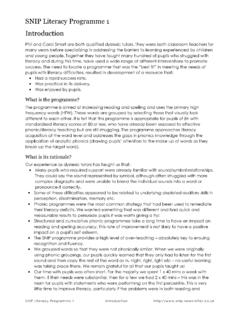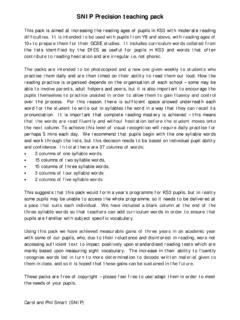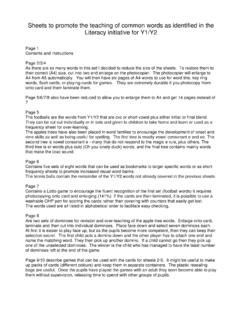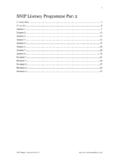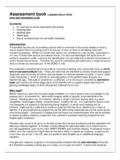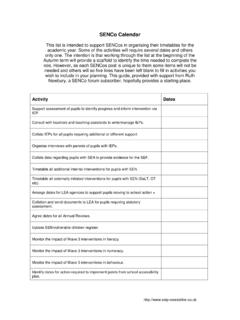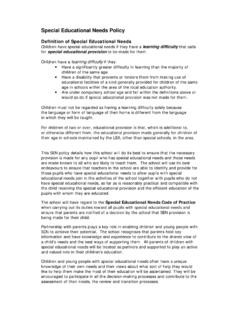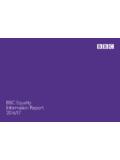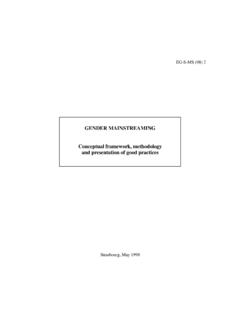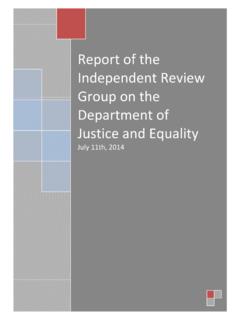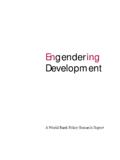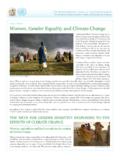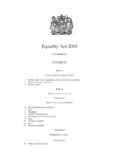Transcription of Special Educational Needs Information Report …
1 1 Special Educational Needs Information Report Sample/Proforma This proforma has been provided as a starting place for schools wishing to meet the statutory reporting regulations of the SEN Information Report . In addition, the questions from the SE7 Local Offer document are included. This proforma will need careful amendment in order to ensure the final policy matches the provision the school offers for pupils with SEND. Once the draft policy has been prepared, this will need sharing with parents to gain their view on accessibility and whether it contains the Information that is of value to them. Amendments resulting from this collaboration will need to be included and once ratified by the whole governors body, the finalised SEN Information Report will then need to be published on the school website and will need renewing annually. It includes the following: 1) Guidance from the SEND Code of Practice (Jan 2015), the Equality Act 2010 and Part 3 of the Children and Families Act 2014 relating to school systems for responding to the Needs of pupils with SEND.
2 2) The Information that schools must Report on in their SEN Information Report . For the purpose of this document, Information on the inclusions in the SEN Information Report has been taken from Schedule 1 of The Special Educational Needs and Disability Regulations 2014. This list is similar to the list included on P95-96 of the SEND Code of Practice July 2014 but in addition includes: requirement to identify additional support for learning that is available to pupils with SEN the contact details of support services for the parents of pupils with SEN including those arrangements made in accordance with section 32, (notices sent by a local authority in regard to mediation) Information on where the Local Authority s (LAs) local offer is published The thirteen statements in Schedule 1 are identified by the bracketed Information ( Schedule 1 Point 4) These are statutory inclusions and must be included to ensure the SEND Information Report complies with the legislation.
3 The responses to the statements can be modified from the suggestions offered but they must respond to the statement.. 3) The questions included in the SE7 Local Offer: Framework and Guidance. These are not statutory, but as the whole thrust of the new legislation is to improve the confidence of parents in the SEN system, these questions, co-produced by parent, carers, young people and professionals on the Information they would like from schools regarding their SEN provision, provides an excellent framework. The fourteen questions are identified below by the bracketed Information ( SE7 1 Q3). 2 Special Educational Needs Information Report Name of the school Date the policy was agreed by Governors 1) Aims of our provision in regards to pupils with Special Educational Needs and/or disability The aims of our policy and practice in relation to Special Educational need and disability in this school are: To make reasonable adjustments for those with a disability by taking action to increase access to the curriculum, the environment and to printed Information for all.
4 To ensure that children and young people with SEN engage in the activities of the school alongside pupils who do not have SEN. To reduce barriers to progress by embedding the principles in the National Curriculum Inclusion statement To use our best endeavours to secure Special Educational provision for pupils for whom this is required, that is additional to and different from that provided within the differentiated curriculum, to better respond to the four broad areas of need: 1. Communication and interaction, 2. Cognition and learning, 3. Social, mental and emotional health, 4. Sensory/physical. To request, monitor and respond to parent/carers and pupils views in order to evidence high levels of confidence and partnership. To ensure a high level of staff expertise to meet pupil need, through well-targeted continuing professional development.
5 To support pupils with medical conditions to achieve full inclusion in all school activities by ensuring consultation with health and social care professionals in order to meet the medical Needs of pupils. To work in cooperative and productive partnership with the Local Authority and other outside agencies, to ensure there is a multi-professional approach to meeting the Needs of all vulnerable learners. 2) What are Special Educational Needs (SEN) or a disability? At our school we use the definition for SEN and for disability from the SEND Code of Practice (2014). This states: Special Educational Needs : A child or young person has Special Educational Needs if he or she has a learning difficulty or disability which calls for Special Educational provision to be made for him or her. A learning difficulty or disability is a significantly greater difficulty in learning than the majority of others of the same age.
6 Special Educational provision means Educational or training provision that is additional to, or different from, that made generally for others of the same age in a mainstream setting in England 3 Disability: Many children and young people who have SEN may have a disability under the Equality Act 2010 that is ..a physical or mental impairment which has a long-term and substantial adverse effect on their ability to carry out normal day-to-day activities . This definition includes sensory impairments such as those affecting sight or hearing, and long-term health conditions such as asthma, diabetes, epilepsy, and cancer. 3) The kinds of Special Educational Needs (SEN) for which provision is made at the school (Schedule 1: point 1) Children and young people with SEN have different Needs , but the general presumption is that all children with SEN but without an Education, Health and Care Plan (EHCP) are welcome to apply for a place at our school, in line with the school admissions policy.
7 If a place is available, we will undertake to use our best endeavours, in partnership with parents, to make the provision required to meet the SEN of pupils at this school. For children with an EHCP, parents have the right to request a particular school and the local authority must comply with that preference and name the school or college in the EHC plan unless: o it would be unsuitable for the age, ability, aptitude or SEN of the child or young person, or o the attendance of the child or young person there would be incompatible with the efficient education of others, or the efficient use of resources. Before making the decision to name our school in a child s EHCP, the local authority will send the governing body a copy of the EHCP and then consider their comments very carefully before a final decision on placement is made. In addition, the local authority must also seek the agreement of school where the draft EHCP sets out any provision to be delivered on their premises that have been secured through a direct payment (personal budget).
8 Parents of a child with an EHCP also have the right to seek a place at a Special school if it they consider that their child s Needs can be better met in specialist provision. 4) How does our school know if children need extra help? (SE7 1 Q1) (Schedule 1: Point 2) We know when a pupil Needs help if: Concerns are raised by parents/carers, external agencies, teachers, the pupil s previous school or the pupil themselves, regarding concerns relating to inadequate levels of progress or inclusion. Screening, such as that completed on entry or as a result of a concern being raised, indicates gap in knowledge and/or skills. Whole school tracking of attainment outcomes indicates lack of expected rate of progress. Observation of the pupil indicates that they have additional Needs 5) What should a parent do if it thinks their child may have Special Educational Needs ?
9 (SE7 1 Q1) (Schedule 1: Points 2 and 4) If parents have concerns relating to their child s learning or inclusion then please initially discuss these with your child s teacher/subject teacher/ form tutor. This then may result in a referral to the school SENCo whose name is .. and whose contact details 4 Parents may also contact the SENCo or the Headteacher directly if they feel this is more appropriate. All parents will be listened to. Their views and their aspirations for their child will be central to the assessment and provision that is provided by the school. 6) How will the school support a child with SEND? (SE7 Q2) (Schedule 1: Points 2, 3, 6, 8 and 10) All pupils will be provided with high quality teaching that is differentiated to meet the Needs of all learners. The quality of classroom teaching provided to pupils with SEND is monitored through a number of processes that include: 1.
10 Classroom observation by the senior leadership team, the SENCo, external verifiers, 2. ongoing assessment of progress made by pupils with SEND, 3. work sampling and scrutiny of planning to ensure effective matching of work to pupil need, 4. teacher meetings with the SENCo to provide advice and guidance on meeting the Needs of pupils with SEND, 5. pupil and parent feedback on the quality and effectiveness of interventions provided, 6. attendance and behaviour records. Pupils with a disability will be provided with reasonable adjustments (such as auxiliary aids and services) to overcome any disadvantage experienced in schools and increase their access to the taught curriculum. All pupils have individual national curriculum targets set in line with national outcomes to ensure ambition. Parents are informed of these via the reporting system and also at events such as Parents Evenings.

